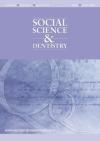Social Science and Dentistry

- Cover Date:
- June 2012
- Print ISSN:
- 2040-4263
- Vol:
- 2
- Issue:
- 1
Editorial
In this edition of the journal we have published both original research papers, and commissioned articles from academics working in the dental field. It is a central tenet of the journal Social Science and Dentistry that not only can the social sciences enrich our understanding of dentistry, but that by studying dentistry we can learn more about psychology and sociology. The interplay of the social sciences and dentistry does not simply comprise the use of psychological methods and theory to inform our understanding of dental health related behaviours and experience, it also necessarily means that by studying aspects of dentistry we are able to develop and shape theory in the social sciences. In July 2010 four psychologists working in dental research approached the British Psychological Society with a proposal to run four seminars touching on different aspects of psychology and oral health. In this and the following issue of the journal we will present the summary papers written by presenters at these symposia. The first seminar explored the area of dental anxiety and phobia, and was hosted at the University of Nottingham. It included talks on three key issues: the acquisition of dental fear and its assessment, the prevalence of dental anxiety and phobia and its impact on well being and approaches to the management of dental anxiety. The manuscripts from these talks are included here. The second seminar explored psychological aspects of head and neck cancer, and was held in London. On the basis of a novel theoretical model of symptom perceptions, Suzanne Scott is developing interventions to encourage early recognition and help-seeking amongst high risk groups. Given the high relapse rates amongst individuals with treated head and neck cancer, fear of recurrence is rational but distressing. Gerry Humphris described his work exploring the nature of fear of recurrence and interventions to ameliorate the impact of these concerns. The impact of head and neck cancer on quality of life is marked, the manuscript by Carrie Llewellyn describes her work characterising the nature of this impact. In our next issue we will include papers from the remaining two seminars. The University of Sheffield hosted a seminar on psychological adjustment to chronic oral health conditions in children and young people. Two papers from this seminar will be presented; Children’s accounts of the cleft lip and palate care pathway and childhood dental injuries: A resiliency model of adaptation. The final seminar took place in Birmingham and took as its premise the critical dependence of dental health on a set of well characterised behaviours, notably reducing the frequency of consumption of sugar containing foods, tooth brushing and flossing and regular dental visits. Falko Sniehotta’s work will be presented describing the impact of interventions based on social cognitions (notably planning interventions) on flossing behaviour. Similarly the compliance of dental practitioners with evidence based practice guidelines is susceptible to analysis through social cognition models, as will be described by Debbie Bonetti. We hope that you will enjoy these manuscripts and that they will serve as inspiration for future research, and future researchers in the Social Science and Dentistry. Tim Newton Sasha Scambler Editors Social Science & Dentistry
- Article Price
- £15.00
- Institution Article Price
- £
- Page Start
- 2
- Page End
- 2
- Authors
- Tim Newton, Sasha Scambler
Articles from this issue
- Title
- Pg. Start
- Pg. End
- Perceptions of Australian Mothers on Infant Teething: A Pilot Investigation Using a Mixed Methods Approach
- 3
- 11
- AFTER and beyond: cancer recurrence fears and a test of an intervention in oral and oropharyngeal patients
- 29
- 38
